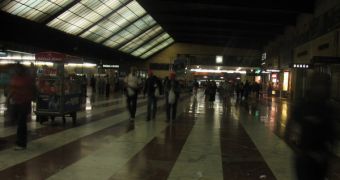The East Japan Railway Company (JR East) has announced that it will outfit the floor of its Tokyo railway station with piezoelectric devices that have the capacity to draw electricity from the steps of those passing in front of ticket booths. For now, the experiment will be fairly limited, covering a small area, but, if successful, the system will be implemented at a large scale, probably in all railway or subway stations in Japan, or even worldwide.
According to company officials, the piezoelectric system will be able to supply 1,400 kW/sec under normal traffic conditions, which means that it could power up all displays in the station by itself. Of course, the amount of electricity it puts out is directly dependent on the number of people walking over it, to trigger the electric potential of thousands of tiny devices.
Piezoelectric materials, usually crystals or ceramics, have the capability to generate a small amount of current, when they are subjected to mechanical pressure, such as pushing, bending, twisting, and turning. Multiple such materials, placed near each other in densely-trafficked areas, could power up even larger structures, provided that the stream of passengers is large enough.
The limitations that these materials have are the same as for nearly all renewable energy sources – once the "trigger" (the Sun, the wind, human steps etc.) is gone – the power-generating capacity decreases drastically. The test portion of the railway in Tokyo will only have about 25 sq meters (82 square feet), and it will still be capable of producing sufficient amounts of current.
The piezoelectric materials will start undergoing testing on December 10th and will function non-stop until February 2009. Company representatives are very hopeful that the system will function within expected parameters, and that they will move to larger scale operations by the half of next year.

 14 DAY TRIAL //
14 DAY TRIAL //